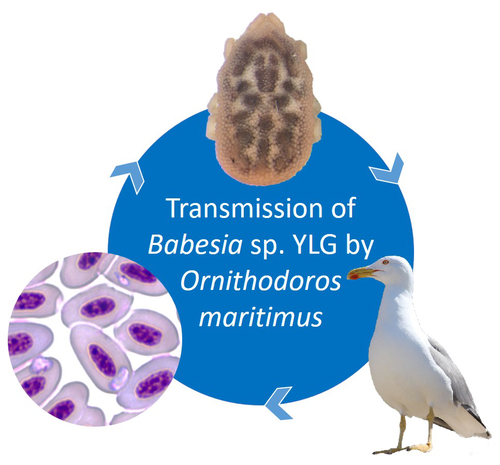
JOURDAN-PINEAU Hélène
- BIOS, CIRAD, Montpellier, France
- Evolution of hosts, infectious agents, or vectors, Pesticide resistance, Population genetics of hosts, infectious agents, or vectors, Vectors
- recommender
Recommendations: 0
Review: 1
Review: 1

A soft tick vector of Babesia sp. YLG in Yellow-legged gull (Larus michahellis) nests
A four-year study reveals the potential role of the soft tick Ornithodoros maritimus in the transmission and circulation of Babesia sp. YLG in Yellow-legged gull colonies.
Recommended by Thomas Pollet based on reviews by Hélène Jourdan-Pineau and Tahar KernifWorldwide, ticks and tick-borne diseases are a persistent example of problems at the One Health interface between humans, wildlife, and environment (1, 2). The management and prevention of ticks and tick-borne diseases require a better understanding of host, tick and pathogen interactions and thus get a better view of the tick-borne pathosystems.
In this study (3), the tick-borne pathosystem included three component species: first a seabird host, the Yellow-legged gull (YLG - Larus michahellis, Laridae), second a soft nidicolous tick (Ornithodoros maritimus, Argasidae, syn. Alectorobius maritimus) known to infest this host and third a blood parasite (Babesia sp. YLG, Piroplasmidae). In this pathosystem, authors investigated the role of the soft tick, Ornithodoros maritimus, as a potential vector of Babesia sp. YLG. They analyzed the transmission of Babesia sp. YLG by collecting different tick life stages from YLG nests during 4 consecutive years on the islet of Carteau (Gulf of Fos, Camargue, France). Ticks were dissected and organs were analyzed separately to detect the presence of Babesia sp DNA and to evaluate different transmission pathways.
While the authors detected Babesia sp. YLG DNA in the salivary glands of nymphs, females and males, this result reveals a strong suspicion of transmission of the parasite by the soft tick. Babesia sp. YLG DNA was also found in tick ovaries, which could indicate possible transovarial transmission. Finally, the authors detected Babesia sp. YLG DNA in several male testes and in endospermatophores, and notably in a parasite-free female (uninfected ovaries and salivary glands). These last results raise the interesting possibility of sexual transmission from infected males to uninfected females.
As pointed out by both reviewers, this is a nice study, well written and easy to read. All the results are new and allow to better understand the role of the soft tick, Ornithodoros maritimus, as a potential vector of Babesia sp. YLG. They finally question about the degree to which the parasite can be maintained locally by ticks and the epidemiological consequences of infection for both O. maritimus and its avian host. For all these reasons, I chose to recommend this article for Peer Community In Infections.
References
- Dantas-Torres et al (2012). Ticks and tick-borne diseases: a One Health perspective. Trends Parasitol. 28:437. https://doi.org/10.1016/j.pt.2012.07.003
- Johnson N et al (2022). One Health Approach to Tick and Tick-Borne Disease Surveillance in the United Kingdom. Int J Environ Res Public Health. 19:5833. https://doi.org/10.3390/ijerph19105833
- Bonsergent C, Vittecoq M, Leray C, Jouglin M, Buysse M, McCoy KD, Malandrin L. A soft tick vector of Babesia sp. YLG in Yellow-legged gull (Larus michahellis) nests. bioRxiv, 2023.03.24.534071, ver. 3 peer-reviewed and recommended by Peer Community in Infections. https://doi.org/10.1101/2023.03.24.534071